Introduction
The Fragile State Index is an annual assessed report on countries’ social, economic, and political perspectives, giving indicators for each country. The data is extracted using qualitative and quantitative measures in that 179 countries are examined and ranked according to their fragility status. As of 2022, Yemen is the most fragile country, followed by Somalia and Syria. South Sudan and the Central African Republic take four and five positions, respectively (Measuring Fragility Risk and Vulnerability in 179 Countries, 2022). Finland is the least fragile state, while Norway and Iceland follow in that order.
This report compares Haiti and Lebanon’s fragility by giving key differences and similarities with comprehensive analysis and discussion. Comparing results for Haiti and Lebanon helps realize each country’s key variables that have contributed to the state of fragility. The overall trend between 2006 and 2022 shows that both countries have experienced increased fragility levels. For instance, Haiti has a total score of 99.7, while Lebanon has 91.3, as shown in Figure 1 below, which means Lebanon is a less fragile state when compared to Haiti. In 2006, Haiti was ranked 8th, while in 2022, it was ranked 11th, while Lebanon is ranked 65th and now 27th using the same year trajectories (“Measuring Fragility Risk and Vulnerability in 179 Countries, 2022”). Therefore, the indicators can tell how the countries differ or relate by using the variables given.
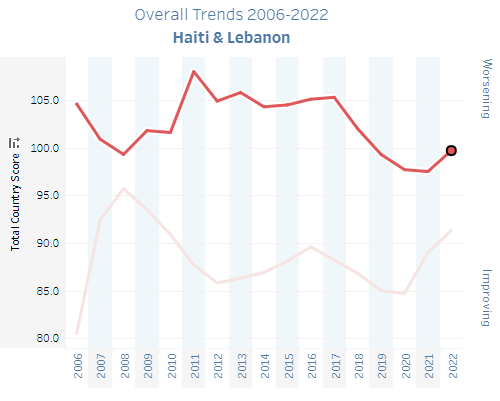
The type of research method used in this case is secondary data analysis. The reason is that the report used existing research data on the fragility status compiled yearly. The key differences between the two countries are that Haiti’s security apparatus is improving while Lebanon’s security is worsening. Additionally, the economy of Haiti is improving while Lebanon is going down. The other difference is that Haiti’s external intervention has deteriorated while Lebanon’s has shown some improvements by checking data between 2006 and 2022. The research question for this report is ‘What are the key similarities and differences in the fragile index between Haiti and Lebanon?
Variables that Show Similarity
Factionalized Elites
Some indicators show the countries to be similar depending on the rates shown in the global data. The first variable concerns factionalized elites, where the two countries have shown similar trends, as seen in figure 2 below. The red curve shows Haiti, while the light curve is for Lebanon. For example, as of 2020-2022, Lebanon and Haiti have a 9.6 score rate meaning the countries have shared that faction (Measuring Fragility Risk and Vulnerability in 179 Countries, 2022). The difference in those years has ranged between 1-2 for the two states; hence, that is another uniformity that can be seen in the data. For instance, since independence, Haiti has been ruled by people of color, and most of them are never elected per democratic rule (Joseph & Pierre-Louis, 2021). The influence of political elites has made a tyrant that attracts Haiti’s poverty to go high. On the other hand, Lebanon has been associated with the eventual rise of debts caused by subscription for unstable political heat due to factionalized elites (Wilson, 2020). Thus, the two countries have had significant levels showing varying factionalized elites.
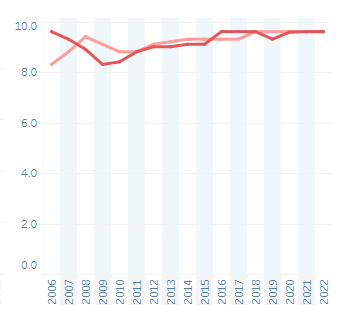
State Legitimacy
The other notable similarity between the fragile index for Haiti and Lebanon is state legitimacy. The two countries have experienced the same variability from 2006 up to 2022. For instance, in 2021, Haiti’s rate for state legitimacy was 8.8, but it has worsened to 9.8 in 2022 (“Measuring Fragility Risk and Vulnerability in 179 Countries, 2022”). The same has been witnessed in Lebanon, where in 2021, the same variable was at 7.7, while in 2022, dropping to 7.8 (“Measuring Fragility Risk and Vulnerability in 179 Countries, 2022”). According to Malaeb (2018), the significant threat to state legitimacy in Lebanon is the existing arms race witnessed in the hands of citizens and major political parties. Some factors have undermined the state legitimacy in Lebanon, namely, the flawed electoral system, the constraints visible in the criminal administration system, and illegitimate arms (Malaeb, 2018). For example, a majority system in the country has contributed to lengthened parliamentary tenure, and an individual’s popularity determines the choice of candidates.
Similar issues are also rampant in Haiti, where the ideal responsibility of politicians shows significant loopholes. For example, the country has been associated with violence and political assassinations undermining its legitimacy (Page, 2022). For example, there sparked unhealthy political tension after the assassination of their president Jovenel Moise in July 2021 (Teo, 2021). Thus, that appears to be a notable breach of state legitimacy for the country. The hypothesis is that differences and similarities in the fragile index for given countries result from political and economic aspects based on the administration of the states and the growing globalization.
Variables Showing Differences
Security Apparatus
Both Haiti and Lebanon have experienced different aspects of security apparatus. For example, between 2006 and 2007, Lebanon had worsening security when Haiti was improving. Haiti had a scoring rate of 9.4 that dropped to 8.4 between 2006 and 2008, while Haiti showed a decreased score rate from 7.0 to 9.0 for the same year, as seen in Figure 3 below (“Measuring Fragility Risk and Vulnerability in 179 Countries, 2022”). Between 2012 and 2016, Haiti experienced an improved fragile index for this matter while Lebanon struggled for the same. Between 2021 and 2022, Haiti boosted its security apparatus, but Lebanon noted a worsening of the same (“Measuring Fragility Risk and Vulnerability in 179 Countries, 2022”). Despite growing instability in Haiti, the intervention by the U.S. helped develop ties that brought peace to the country.
The political class in any country can control the security apparatus. According to the Center for Preventive Action (CPA), the implementation of the Global Fragility Act (GFA) will necessitate the U.S. to work with Haiti to end political instabilities that disrupt peace (Page, 2022). On the other end, Lebanon has had new challenges in its security apparatus in delivering security assistance which has made the country experience the problem. General Security (G.S.) and the General Directorate of State Security (GDSS) have overlapped over the responsibility of maintaining internal security (Arakji, 2021). The challenge is political, where leaders have used them to strengthen their network instead of investing in how to boost security.
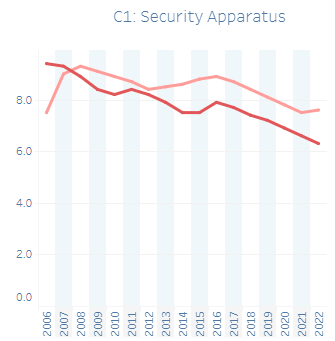
Demographic Features
There is a significant difference between Lebanon’s and Haiti’s demographic pressures. Haiti shows high fragility when it comes to this matter compared to Lebanon, which is slightly lower. Haiti has a scoring rate of 8.7 while Lebanon has 5.7, meaning that Lebanon has not been affected by the demographic pressure the way Haiti has shown, as evident in Figure 5 (“Measuring Fragility Risk and Vulnerability in 179 Countries, 2022”). Between 2007 and 2017, Haiti had a worsening effect of demographic pressure, while Lebanon seemed to be combating the issue. Some contributing factors to demographic pressure include economies of scale, human rights, inequality and quality issues, and brain drain (Khatib, 2021). Haiti has a population of more than 11 million, while Lebanon has close to 7 million (Council on Foreign Relations, 2022). Therefore, it means the gap in population may influence the two nations’ gross domestic product (GDP).
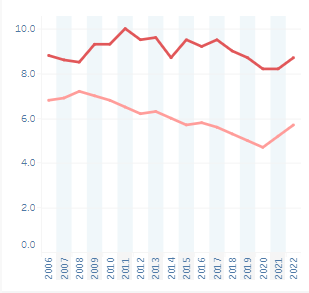
In Lebanon, women have been empowered of late and can participate in developmental issues such as how to combat climate change in their country. For example, women have been driving energy towards undertaking initiatives that change, such as producing sustainable energy and creating ecosystems that can benefit the well-being of the citizens (Khatib, 2021). Those are key elements that make Lebanon better placed regarding demographic pressure. Haiti has been challenged by the concept of empowering women through gender-based violence (GBV), which is a form of severe inequality (Page, 2022). 33% of women in Haiti have not been empowered fully, which makes the demographic features contribute to the existing pressures (OECD, 2022). Therefore, the difference between the two countries is evident from contemporary issues affecting their regions’ demographic issues.
Public Services
Haiti and Lebanon experience different rates of fragility in public services. As of 2022, Haiti has a score index of 9.7 while Lebanon has 6.7, meaning various factors contribute to the gap (“Measuring Fragility Risk and Vulnerability in 179 Countries, 2022”). Between 2008 and 2021, Lebanon showed worsening public services; in Haiti, it was up and down, with the discrepancy being minimal. Lebanon appears to be struggling with public service issues because between 2021 and 2022, the rate changed from 4.8 to 6.7, while Haiti only experienced a difference of -1, which means there was no significant drop, as seen in Figure 6 below (“Measuring Fragility Risk and Vulnerability in 179 Countries, 2022”). There is an evident crisis in Lebanon where deliberate depression has led to collapse in public services. The mass brain and internal political perspectives have served as the basis for this phenomenon.
Public services have been affected due to economies of scale. World Bank Group (2021 par.5) says that “The Great Denial,” Lebanon’s deliberate depression is orchestrated by the country’s elite that has long captured the state and lived off its economic rents. This capture persists despite the severity of the crisis –one of the top ten, possibly top three most severe economic collapses worldwide since the 1850s….” That means Lebanon’s public service has been threatened by instability from social and political perspectives. In Haiti, there have been strategic programs meant to boost public service. For example, the 2023 State Modernization Program of the Office of Management and Human Resources (OMRH) has enabled the revival of public service (OECD, 2022). That saw reforms hence, strengthening the quality of services delivered to people.
From the hypothesis formulated, it is true that Haiti and Lebanon have key variables that are different, making each take a position in the fragility status. This discussion of the above variables confirms that Haiti is still struggling to stabilize the fragile index and Lebanon. The differences are clear that both countries have unique political and social autonomy, which makes each have varied indicators when it comes to key elements that define the status of a country from the global perspective.
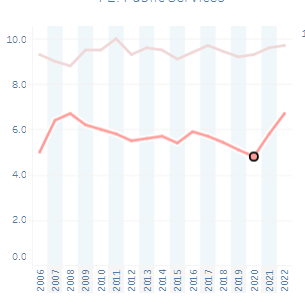
Conclusion
From the analysis of the above similarities and differences, various lessons can be depicted. First, Haiti is at a higher risk of fragility than Lebanon, as shown by the indicators in the global data. However, each country has specific areas where it outperforms the other depending on the field of interest. For example, Haiti’s public service is worse than that of Lebanon. Second, these two countries are among the top regarding political and social instabilities. Lebanon is frequently affected by internal conflicts, while Haiti has seen significant pressure from political instability that has led to issues such as assassinations, lack of democracy, and failure to uphold the rule of law.
The other lesson is that private and public partnerships have played a key role in combating state failures, such as the U.S.’s intervention and the World Bank’s strategic involvement in developing the two countries. Additionally, there is a lesson about economic decay resulting from failing to commit fully to innovative measures that can be put in place. For example, Haiti has not yet worked towards combating factionalized elites who have created systems of cartels in government. According to the understanding of that aspect, it can lead to state capture. Most of the problems that make these states fail are related to politics and social and economic scales. For example, financial turmoil is brought about by a lack of centralizing resources to serve the interest of common citizens.
An interpretation of the failed judicial system is that the matter may lead to corruption and embezzlement of funds that can worsen the economic factions. The other lesson is that illegitimate arms are one of the causes of the state of fragility in Lebanon. For example, the civil war in Lebanon has been caused by an arms race powered by political cartels. Therefore, it means politics can lead to a fallen state, increasing its fragile index globally.
The understanding of state fragility has been altered because of what is seen in the global data on the fragile index for countries. For example, brain drain appears to be a factor many people may overlook when it comes to a country’s fragility levels. That means if people move out of their countries to seek greener pastures, their countries may continue to languish in poverty while developing foreign states. The hypothesis has been adjusted in that the causes of state fragility are centered on political, social, and economic concepts with contributions from all elements of life that concern human beings. To understand the fragile index, one does not have to check politics and the economy on a contemporary basis. Rather, they should dig deeper to evaluate the link between the above factions, noting the disregarded concepts that may influence the outcome.
References
Arakji, D. (2022). Lebanon: New challenges to the delivery of Security Assistance. ISPI. Web.
Council on Foreign Relations. (2022). A conversation with foreign minister Abdallah Bouhabib of Lebanon. CFL. Web.
Joseph, S. M., & Pierre-Louis, F. (2021). How domestic elites and foreign meddling undermine Haitian democracy. In These Times. Web.
Khatib, L. (2021). How Hezbollah holds sway over the Lebanese state. Chatham House – International Affairs Think Tank. Web.
Malaeb, B. (2018). State fragility in Lebanon: Proximate causes and sources of – IGC. LSE. Web.
“Measuring Fragility Risk and Vulnerability in 179 Countries (2022).” Fragile States Index. Web.
OECD. (2022). Strategic management of the public service in Haiti. OECD i-Library. Web.
Page, S. (2022). A smarter U.S. Assistance Strategy for Haiti. Council on Foreign Relations. Web.
Teo, J. (2021). Why political legitimacy in Haiti matters to all. NST Online. Web.
Wilson, W. (2020). From one crisis to the next in Lebanon. Fragile States Index. Web.
World Bank Group. (2022). Lebanon’s crisis: Great denial in the deliberate depression. World Bank. Web.